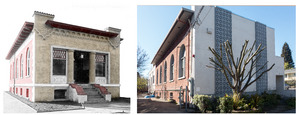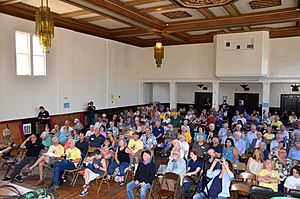California Historical Radio Society facts for kids
The California Historical Radio Society (CHRS) is a non-profit group. It focuses on the history of radio and radio broadcasting. This includes old TVs, amateur radio (ham radio), and HiFi sound systems. CHRS mainly looks at the history of early radio in California, especially around the San Francisco Bay Area and the western United States. Its museum and main office, called "Radio Central," are in Alameda, California.
Contents
The Story of CHRS: How It Began
The California Historical Radio Society (CHRS) was started in 1974. Norman Berge, Jim Cirner, Gene Rippen, and others founded it. It became a non-profit organization.
In 2003, CHRS took over the Bay Area Radio Museum and Hall of Fame. This museum was started by David Ferrell Jackson in Berkeley, California. It was originally only online.
Later, in 2012, CHRS also joined with the Society of Wireless Pioneers. This group was managed by Waldo Boyd. CHRS now keeps their old records and has restarted their website. They share historical materials and comments there.
CHRS also received the radio archives and library of James Maxwell. They now use his amateur radio callsign, W6CF, for their own ham radio activities. In 2014, CHRS moved its home to Alameda. Before that, it was in a temporary spot at the old KRE radio station in Berkeley.
What CHRS Does: Events and Activities
Each summer, CHRS holds a special event called "Radio Day by the Bay." This is a fundraiser where they perform old-fashioned radio shows from the Golden Age of Radio.
Every fall, CHRS honors important local broadcasters. They add these people to their Bay Area Radio Hall of Fame.
Sharing Radio History
CHRS creates and shares many things about radio history. They publish texts, videos, and audio recordings. These materials cover topics like how radios were restored and news about their current projects, including amateur radio.
- The Society of Wireless Pioneers (SOWP) focuses on the people who used early wireless telegraphy. This includes radio operators on ships and the changing technologies they used.
- The Bay Area Radio Museum and Hall of Fame mainly celebrates local radio industry people. It also keeps old broadcast recordings, documents, photos, and other historical items from radio stations in the San Francisco Bay Area.
Awards and Recognition
The CHRS Journal is managed by the Society. This journal helped CHRS get recognized by the Antique Wireless Association (AWA) in New York. AWA gave CHRS its annual Houck Award in 2015. They also gave CHRS the Taylor Television Award in 2020.
AWA has also given the Houck Award to two CHRS historians: Mike Adams in 1995 and Bart Lee in 2003. Bart Lee also won the first Murray Award in 2018 for the best article in the AWA Review. In 2020, Adams and Lee became the first AWA Fellows.
Inside the Museum
The museum has a display about the history of television. Physicist Dr. John W. Staples manages this display, which is always being updated.
The W6CF amateur radio station is also at the museum. It has its own "radio shack" where they use both modern and old ham radio equipment.



